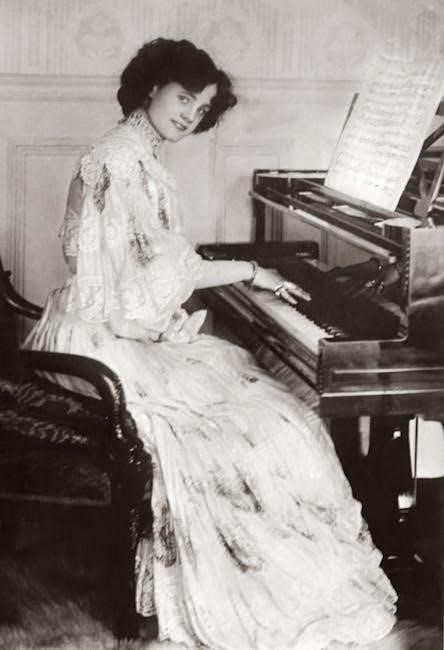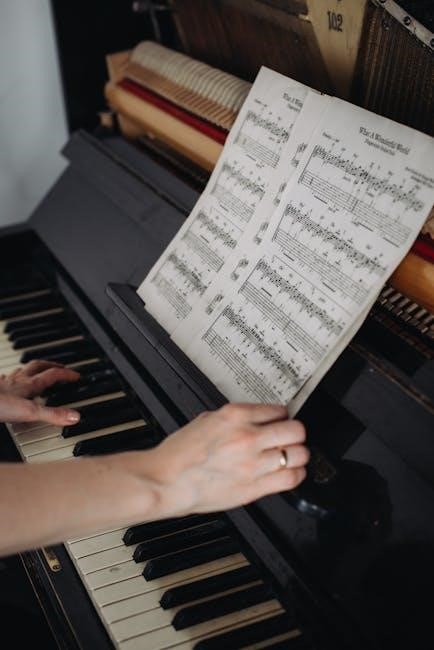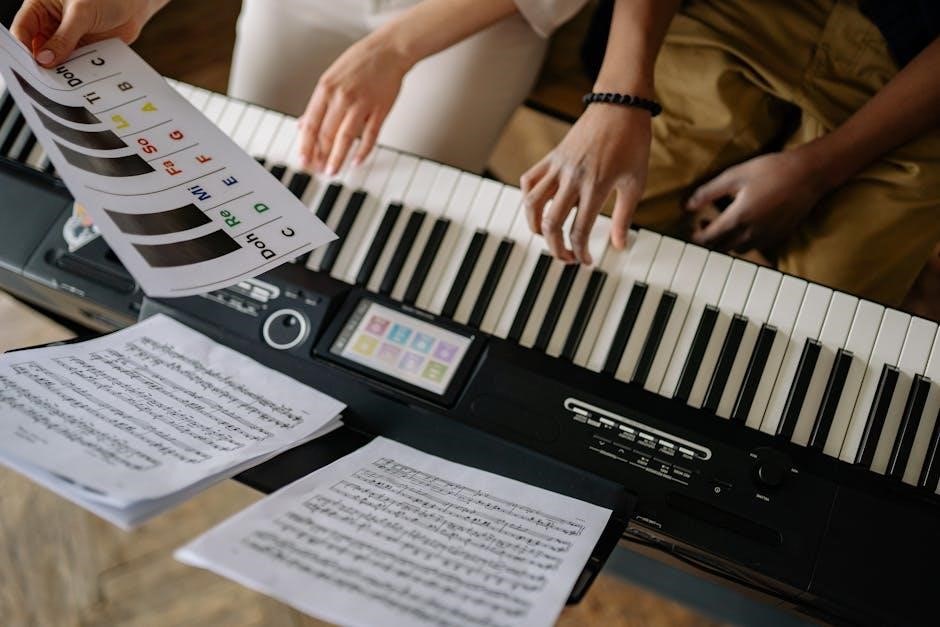The Interstellar soundtrack, composed by Hans Zimmer, has captivated audiences worldwide with its hauntingly beautiful melodies, making its piano arrangements highly sought after by musicians and enthusiasts alike.

1.1 Overview of the Movie and Its Music
Interstellar, directed by Christopher Nolan, is a visually stunning film that explores themes of space exploration, time, and human emotion. Starring Matthew McConaughey, Anne Hathaway, and Jessica Chastain, the movie delves into the journey of astronauts traveling through a wormhole in search of a new home for humanity. The soundtrack, composed by Hans Zimmer, plays a pivotal role in enhancing the film’s emotional and philosophical depth. Zimmer’s score features a mix of orchestral and choral elements, with the iconic use of the organ, creating a haunting yet majestic sound. The music seamlessly complements the film’s visual grandeur, evoking feelings of awe, hope, and introspection. This harmonious blend of visuals and sound has made Interstellar a timeless classic, inspiring many to seek out its sheet music for piano performances.

1.2 The Role of Hans Zimmer in the Soundtrack
Hans Zimmer, the mastermind behind the Interstellar soundtrack, crafted a deeply emotional and atmospheric score that perfectly complemented the film’s narrative. His innovative use of instruments, particularly the organ, created a sense of cosmic grandeur. Zimmer’s ability to evoke complex emotions through music is evident in tracks like Time and Arrival, which have become iconic in modern cinema. His approach to manipulating time signatures and harmonic progressions added layers of depth, making the score unforgettable. Zimmer’s collaboration with director Christopher Nolan ensured the music was integral to the storytelling, enhancing the film’s thematic exploration of love, time, and survival. His work on Interstellar solidified his legacy as a visionary composer, inspiring pianists to reinterpret his pieces with passion and precision.
1.3 Why “Interstellar” Resonates with Piano Enthusiasts
The emotional depth and complexity of Interstellar’s score make it a magnet for pianists. Its themes, such as “First Step,” blend simplicity with profound emotion, resonating deeply with those who play them. The minimalist yet powerful compositions create a sense of space and time, aligning with the film’s cosmic narrative. Pianists are drawn to the challenge of capturing the music’s haunting beauty, while its accessibility makes it rewarding for both beginners and advanced players. The sheet music’s availability and versatility across skill levels further enhance its appeal, allowing pianists to connect with the film’s emotional core and express it through their own interpretations.

Understanding the Composition
Hans Zimmer’s score for Interstellar features unconventional techniques, emotional depth, and intricate harmonies, creating a sonic landscape that reflects the film’s themes of space, time, and human connection.
2.1 The Time Signature and Key of the Piece
The Interstellar theme primarily revolves around a time signature of 4/4, though it occasionally shifts to 3/4 to create a sense of temporal disorientation, reflecting the film’s themes of space and time. The piece is written in the key of C minor, which contributes to its introspective and melancholic tone. This key choice allows for a rich harmonic structure, blending both dissonance and resolution to evoke a sense of cosmic wonder. The tempo is moderate, typically around 60-80 BPM, providing a contemplative pace that aligns with the film’s emotional depth. Understanding these foundational elements is crucial for accurately interpreting and performing the piece on the piano.
2.2 The Emotional Depth of the Music
The Interstellar soundtrack, particularly the piano arrangements, carries profound emotional depth, resonating deeply with listeners. Hans Zimmer’s composition masterfully blends hope and melancholy, creating a sense of cosmic wonder and introspection. The music often transitions between serene melodies and intense, climactic crescendos, mirroring the film’s themes of love, sacrifice, and humanity’s existential journey. The piano’s expressive nature amplifies these emotions, allowing players to convey vulnerability and triumph simultaneously. This emotional complexity makes the piece not only technically challenging but also deeply rewarding, as it invites pianists to connect with the music on a personal level and share that connection with audiences.

2.3 The Use of Themes and Motifs
Hans Zimmer’s score for Interstellar relies heavily on recurring themes and motifs to convey emotional and narrative depth. The piano sheet music captures these elements beautifully, with motifs like the haunting “Gravity” theme and the uplifting “No Time for Caution” riff. These musical ideas are woven throughout the soundtrack, often symbolizing concepts like time, space, and human connection. The use of intervals, particularly the Shepard tone, creates a sense of ascending without resolution, mirroring the film’s exploration of the infinite. By repeating and evolving these motifs, Zimmer builds a cohesive narrative that resonates deeply with listeners, making the piano arrangements both challenging and rewarding to play.

Searching for the Right Sheet Music
Finding the right Interstellar sheet music requires careful consideration of arrangement quality, difficulty level, and compatibility with your piano skills for the best experience.
3.1 Factors to Consider When Choosing a Version
When selecting a version of Interstellar sheet music, consider your skill level, as arrangements vary in complexity. Choose a version that matches your technical proficiency, whether you’re a beginner or an advanced pianist. Additionally, look for sheet music that aligns with the emotional depth and tempo of the original composition. Some versions may simplify intricate parts, while others preserve the full complexity of Hans Zimmer’s work. Ensure the arrangement is compatible with your instrument and performance goals. Finally, check the credibility of the source and the arranger to guarantee accuracy and quality. These factors will help you find the most suitable version for your needs.
3.2 Where to Find Reliable Sources Online
When searching for reliable Interstellar sheet music, it’s important to use trusted platforms to ensure quality and accuracy. Websites like Musicnotes and Sheet Music Plus offer high-quality, legally licensed versions of the score, often with multiple arrangements to suit different skill levels. Additionally, platforms like MuseScore and IMSLP provide a mix of free and paid options, though be cautious to verify the quality and accuracy of user-contributed content. Always prioritize official publishers or well-reviewed sources to avoid downloading low-quality or misarranged sheet music. This ensures your practice and performance are supported by precise and professional notation.
3.3 Free vs. Paid Sheet Music: Which is Better?
When searching for Interstellar sheet music, pianists often debate between free and paid options. Free sheet music is appealing for its accessibility and cost-effectiveness, making it ideal for beginners or casual players. However, it may lack the precision and detail of professionally arranged scores. Paid sheet music, while requiring an investment, typically offers higher quality, accurate transcriptions, and additional features like performance notes. For serious pianists, paid versions are often worth the cost for their reliability and completeness. Ultimately, the choice depends on your skill level, commitment, and budget. Always ensure you’re downloading from reputable sources to avoid legal issues and poor-quality arrangements.

Downloading the Sheet Music
Downloading Interstellar sheet music in PDF format is straightforward when using trusted websites, ensuring access to high-quality arrangements that capture the piece’s emotional complexity and depth.
4.1 How to Download the PDF Safely
To ensure a secure download of the Interstellar piano sheet music PDF, prioritize reputable sources like official publishers or trusted sheet music platforms. Verify the site’s reliability through reviews or ratings. Avoid sites with excessive pop-ups or those requesting unnecessary personal information. Look for ‘https’ in the URL and a padlock icon for encrypted connections. Use antivirus software to scan the file post-download. Be cautious of files requiring administrative privileges or additional software installations. Opt for PDFs, which are generally safer than executables. Ensure the site is licensed to distribute the sheet music to comply with copyright laws. Consider using a secure payment method if purchasing and keep transaction records. Employ browser extensions or tools that scan downloads automatically and keep your OS and software updated to protect against vulnerabilities. By taking these precautions, you can safely obtain the sheet music while protecting your device and personal data.
4.2 Legal Considerations for Sheet Music Downloads
Downloading Interstellar sheet music requires adherence to copyright laws. The music, composed by Hans Zimmer, is protected under intellectual property rights, meaning unauthorized distribution or download is illegal. Always use official sources or licensed platforms to obtain the sheet music. Free downloads may violate copyright and expose users to legal penalties. Purchasing from reputable sellers ensures compliance with laws and supports creators. Be cautious of unverified websites offering free PDFs, as they may infringe on copyright. Respecting intellectual property is essential to avoid legal consequences, including fines or legal action. Prioritize legal downloads to enjoy the music responsibly and ethically.
4.3 Troubleshooting Common Issues
When downloading or using Interstellar piano sheet music, common issues may arise. Corrupted files can occur due to incomplete downloads; try re-downloading from a reliable source. Compatibility problems with your PDF viewer or piano software can be resolved by updating your programs or using alternative apps. Printing issues, such as incorrect formatting, can often be fixed by adjusting printer settings or ensuring the PDF is scaled properly. If the sheet music appears blurry, check if it’s a high-resolution version. Legal issues can be avoided by ensuring you’re using licensed or royalty-free versions. Lastly, if the music doesn’t play back correctly in MIDI, verify that your device supports the file format. Always use trusted sources to minimize these problems and ensure a seamless experience.

Practicing the Interstellar Theme
Mastering the Interstellar theme requires patience, as its emotional depth and complex rhythms present both technical and interpretative challenges, especially for pianists aiming to convey its cinematic essence authentically.
5.1 Tips for Beginners
Beginners approaching the Interstellar piano theme should start by breaking the piece into manageable sections. Practice slowly, focusing on accuracy, and gradually increase tempo. Use a metronome to maintain consistent timing. Pay attention to finger placement and hand positioning to avoid strain. Emphasize emotional expression by varying dynamics and articulation. Regular practice, even for short periods, helps build familiarity. Listen to the original soundtrack for inspiration and to understand the intended feel. Don’t hesitate to use tutorials or sheet music with annotations for clarity. Most importantly, embrace the process and enjoy the journey of mastering this iconic piece.
5.2 Advanced Techniques for Seasoned Pianists
Seasoned pianists can elevate their performance of Interstellar by mastering nuanced pedaling techniques, dynamic contrasts, and intricate phrasing. Experiment with varying tempos while maintaining the piece’s emotional core. Pay attention to subtle shifts in timbre and resonance, using the sustain pedal to enhance the ethereal quality of the music. Incorporate advanced fingerings to navigate complex arpeggios and polyrhythms seamlessly. Additionally, explore expressive interpretations by emphasizing motivic development and thematic transformations. For a more dramatic impact, experiment with rubato and dynamic extremes, ensuring the music’s emotional depth resonates with the audience. These techniques will allow seasoned pianists to deliver a captivating and polished rendition of the Interstellar theme.
5.3 The Importance of Tempo and Dynamics
Tempo and dynamics are crucial elements in performing the Interstellar theme. The tempo dictates the pacing, while dynamics control the intensity, creating a dramatic and emotional journey. Adhering to the score’s tempo markings ensures the music flows naturally, maintaining the intended mood. Dynamics, such as the contrast between soft, delicate passages and powerful crescendos, add depth and expression. Pianists should pay close attention to these nuances to evoke the film’s emotional resonance. Practicing with a metronome can help maintain consistent timing, while carefully balancing dynamics will enhance the overall performance. These elements are essential for capturing the haunting beauty and complexity of Hans Zimmer’s composition.

Performing the Piece
Performing Interstellar requires emotional depth, precise timing, and dynamic control to convey the music’s cosmic and heartfelt journey, ensuring a mesmerizing experience for both player and audience.
6.1 How to Captivate Your Audience
To captivate your audience while performing the Interstellar theme, focus on conveying the emotional depth of the music. Use dynamics and tempo to create a sense of tension and resolution, mirroring the film’s dramatic narrative. Maintain eye contact and expressive body language to connect with your audience on a deeper level. Highlight the haunting melodies and powerful crescendos that define the piece, allowing the music to tell its own story. Encourage audience engagement by setting the mood with a brief introduction or visual elements, such as dim lighting or space-themed visuals, to enhance the immersive experience. Most importantly, play with passion and authenticity, ensuring your performance resonates long after the final note fades.
6.2 Incorporating Emotional Expression
Incorporating emotional expression into the Interstellar theme is crucial for capturing its essence. Pianists should focus on dynamics, varying between soft, delicate moments and powerful crescendos to reflect the film’s emotional depth. Tempo fluctuations can emphasize dramatic shifts, while phrasing should convey a sense of longing and hope. Paying attention to pauses and silences allows the music to breathe, enhancing its emotional impact. The minimalist yet complex nature of the score invites pianists to explore subtle nuances, making each performance deeply personal and resonant. By channeling the emotional core of the music, performers can create a profound connection with their audience, ensuring the piece’s beauty and complexity shine through.
6.3 Common Mistakes to Avoid
When performing Interstellar’s piano theme, pianists often make mistakes that detract from the piece’s emotional impact. One common error is rushing through the tempo, especially in the more emotive sections. Players may also neglect dynamics, failing to emphasize the contrasting soft and loud passages that define the music’s intensity. Additionally, improper use of the sustain pedal can muddy the sound, obscuring the clarity of the melody. Another pitfall is overcomplicating the piece with unnecessary embellishments, which can distract from its simplicity and power. Lastly, some performers may overlook the importance of articulation, blending notes together instead of maintaining the crisp, staccato touches that give the theme its haunting quality. Awareness of these mistakes is key to delivering a compelling performance.

Exploring Variations and Arrangements
Explore creative interpretations of the Interstellar theme, from orchestral arrangements to minimalist piano solos, and discover how to craft your own unique version, blending tradition with innovation.
7.1 Different Interpretations of the Theme
The Interstellar theme has inspired a wide range of interpretations, with pianists and arrangers offering unique takes on Hans Zimmer’s original composition. Some opt for minimalist arrangements, focusing on the haunting melodies, while others incorporate intricate harmonies and complex rhythms. These variations highlight the versatility of the piece, allowing pianists to express their personal connection to the music. Additionally, some interpretations blend the piano with other instruments, creating a rich, layered sound that pays homage to the film’s orchestral roots. These diverse approaches ensure that the theme remains fresh and captivating, appealing to both casual listeners and dedicated musicians. Exploring these interpretations can inspire pianists to find their own voice within the music.
7.2 How to Create Your Own Arrangement
Creating your own arrangement of the Interstellar theme allows you to personalize the music while maintaining its emotional core. Start by analyzing the original composition to identify key themes and motifs. Simplify complex sections or adapt them to suit your skill level. Experiment with tempo and dynamics to infuse your unique style. Consider incorporating additional harmonies or layering textures to enhance depth. Use tools like MIDI editors or sheet music software to draft your ideas. Finally, refine your arrangement by ensuring it flows naturally and retains the essence of the original piece. This process not only challenges your creativity but also deepens your connection to the music.
7.3 The Impact of Instrumental Combinations
The combination of instruments in Interstellar sheet music enhances its emotional depth, creating a rich, layered sound. While the piano is central, incorporating strings, woodwinds, or even electronic elements expands the sonic landscape. These combinations elevate the music’s complexity and resonance, offering fresh interpretations of the theme. For example, adding a string section can amplify the piece’s melancholic undertones, while an organ can introduce a sense of grandeur. Such collaborations not only enrich the performance but also allow pianists to explore new dimensions of the composition. Whether performed solo or with an ensemble, the interplay of instruments ensures the music remains dynamic and captivating, staying true to its original essence while inviting creativity and experimentation.
The Interstellar sheet music remains a timeless tribute to Hans Zimmer’s brilliance, offering pianists a deep emotional connection to the film’s cosmic journey. Keep playing with passion.
8.1 The Lasting Appeal of Interstellar’s Music
The music from Interstellar continues to resonate deeply with audiences due to its emotional and philosophical depth. Hans Zimmer’s masterful composition blends orchestral grandeur with intimate, minimalist motifs, creating a timeless sonic experience. The score’s ability to evoke feelings of wonder, loss, and hope ensures its enduring popularity. Piano arrangements, in particular, capture the essence of the original pieces, offering pianists a way to connect with the film’s themes on a personal level. The music’s universal appeal lies in its ability to transcend genre and time, making it a cherished choice for both performance and personal enjoyment. Its lasting impact underscores the power of music to inspire and move people across generations;
8.2 Encouragement to Keep Practicing
Practicing the Interstellar theme requires dedication, but every moment spent at the piano is a step closer to mastering its emotional depth. Celebrate small achievements, like perfecting a difficult phrase or capturing the right sentiment. Remember, the music’s complexity is a testament to its beauty, and persistence will unlock its full expression. Set achievable goals, stay patient, and embrace the journey. Even seasoned pianists face challenges, but it’s through consistent effort that the piece truly comes alive. Keep in mind that every note played is a connection to the film’s profound narrative and Hans Zimmer’s visionary composition. Let your passion for the music guide you, and trust that dedication will transform your performance into something extraordinary.
8.3 Final Thoughts on the Importance of Sheet Music
Sheet music serves as a timeless bridge between composers and performers, preserving the essence of Interstellar’s haunting melodies for generations to come. It not only provides a roadmap for musicians to interpret the piece but also inspires creativity and personal connection. For pianists, having access to high-quality sheet music ensures accuracy and authenticity, allowing them to capture the emotional depth Hans Zimmer intended. Whether for practice or performance, sheet music remains an indispensable tool, fostering a deeper understanding and appreciation of the artistry behind Interstellar. It embodies the enduring power of music to transcend time and space, connecting players and audiences in a shared emotional journey.





